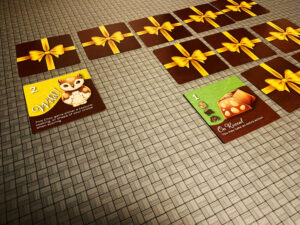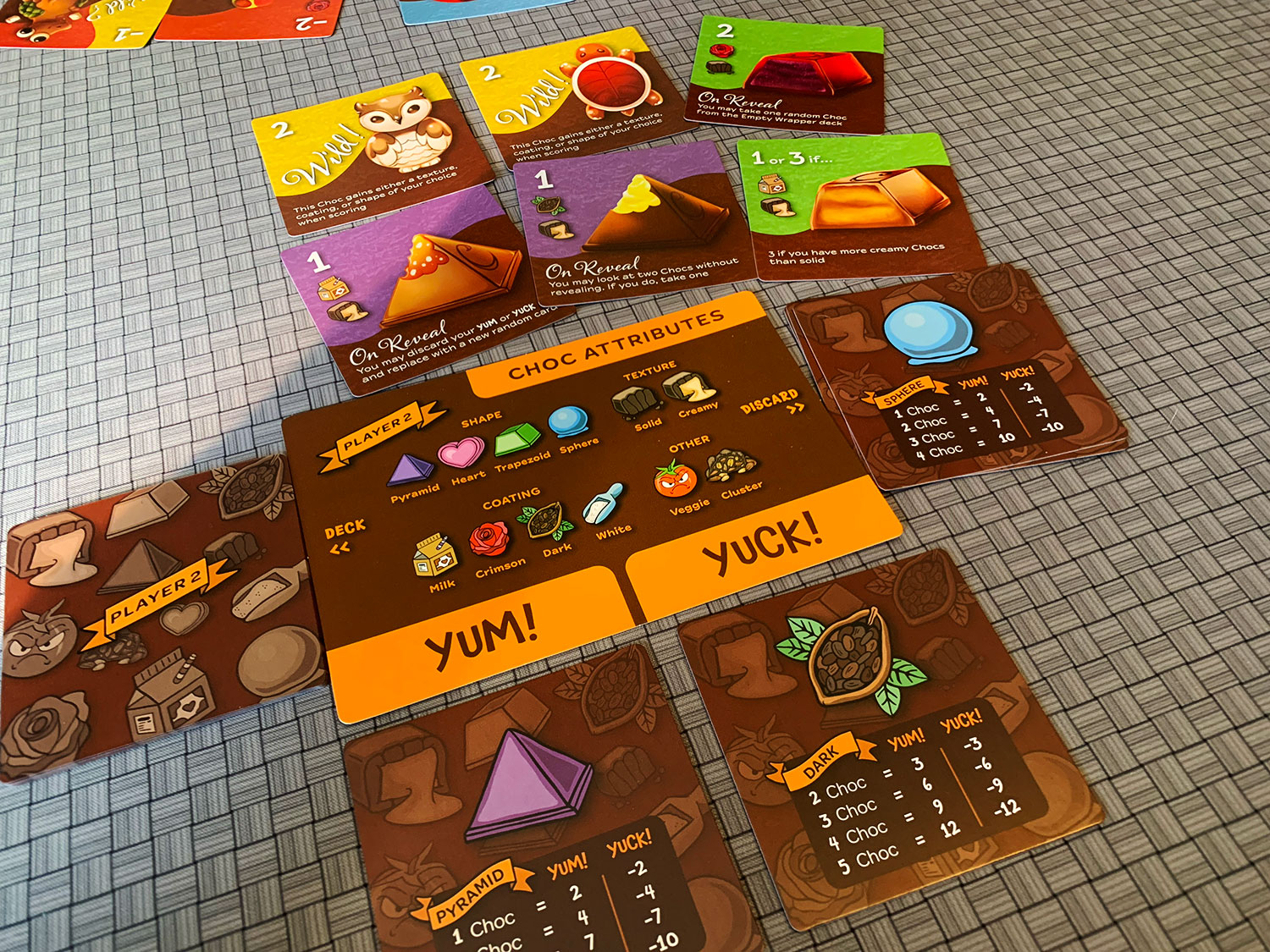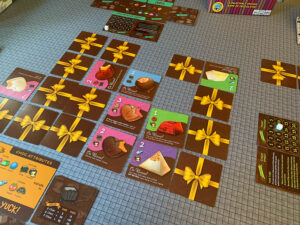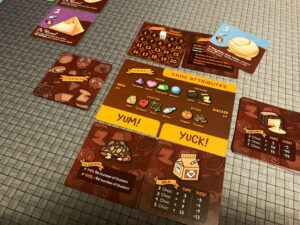 Around the Board Game Quest Discord and many articles, I often make Dad jokes and references to music so a game about chocolates should be a sweet opportunity for plenty of food-related puns. I was all ready to pour some sugar on this review until I saw the chocolate-covered pea pod and realized that this game was designed and illustrated by monsters named Mathew Hocker and Olivia Raum, respectively.
Around the Board Game Quest Discord and many articles, I often make Dad jokes and references to music so a game about chocolates should be a sweet opportunity for plenty of food-related puns. I was all ready to pour some sugar on this review until I saw the chocolate-covered pea pod and realized that this game was designed and illustrated by monsters named Mathew Hocker and Olivia Raum, respectively.
The box says the game is meant for ages 10 and up. My son is only eight so I’m not sure if I’m ready to expose him to these horrors lest it makes him afraid of chocolates. But if he’s afraid there will be more left for me. *Queue dark side music*
“Hey Bud, wanna play a game about chocolates? BitterSweet plays one to four players, and the box says takes 15 to 40 minutes to play.”
Gameplay Overview:
Each player has a deck of cards that will be shuffled at the beginning of the game and each round they’ll draw two cards and place one under their player sheet under the words Yum! and Yuck! (a variant allows you to pick which goes where). These may be looked at but should be kept face down to hide your goals from your opponents.
You’ll need to win two rounds to win the game.
The goal of the game is to collect chocolates from the center of the table that match your secret Yum criteria, while avoiding your yuck criteria using two actions per round. The available actions are:
• Reveal – Flip over a chocolate card (called Chocs to be hip, presumably)
• Take a face up or face down choc (did that make me sound cool? I felt cool)
• Return a choc to the box and take an empty wrapper (another choc card that wasn’t in play) from the supply next to the box. Empty wrappers don’t count towards your round scoring.

Many times, cards will have special abilities that trigger when revealed or if selected face down. If a card allows you to reveal more chocs and those have on reveal abilities, you also get to trigger those.
Each Choc card has a few features including coating, texture, shape, and “other”. The attributes have icons telling you what it is while the shape is illustrated in the art along with a background color that matches the color on your player sheet.
A round ends when there are no Chocs to reveal (all remaining are face up), there are no Chocs left, or a player has two empty wrappers. Whoever has the most points in a round wins and will flip their player sheet over to signify they’re one step closer to winning. Points do not carry over between rounds and new yuck and yum cards are revealed.
There is also a solo mode where an automata follows a very basic logic to gather cards and the first to win two rounds wins.

Game Experience:
On the surface, this almost seems like memory (and there is that aspect as a few chocs allow players to flip cards face down) but it’s more than that. There’s a dash of take that as you can pass cards to or take cards from other players but that’s not a central feature. There’s a pinch of press your luck if you want to grab random chocs from box. It’s also a horror theme with its chocolate-covered garlic. But mostly, it’s a set collection game that plays in about 10 minutes per round.
Having cards that can match both your yuck and yum is interesting as you’ll need to see if it grants as many positive points as it’s going to possibly cost you. Several of the Yucks and Yums require multiple cards to trigger the next scoring tier, that one pyramid chocolate isn’t going to hurt me, is it?

I typically would reveal a card and then take it, if advantageous on my turns and every now and then would trigger some ability that allowed me to reveal more cards or do something else. If I was repulsed at what was revealed, I’d reveal a second card. The disadvantage, especially against the bot player, is their logic is to take face-up cards or reveal if none are face-up. And they don’t have a yuck card so they can stockpile points fast. Against other humans, you kind of give away some preferences which can allow people to know what you might really dislike. But with each chocolate having three features it might take a few turns for that to stick which would also be harder as player count goes up.
The randomness of both the cards in play and your taste/texture/shape preferences makes it hard to game the system when the box gets low on choices. That randomness, since only a portion of the full deck of chocs is used each round, also means that there may not be a lot of your yums in play in any given round. Even only having to track shape, coating, and filling – I’ve somehow collected piles of my Yucks because the cards are face down and I got mixed up.

BitterSweet is relatively easy to teach and play and has a fairly limited decision-space—especially for those who don’t want to press-their-luck with blind drawing chocolates. A thoughtful player will likely do better than someone who’s more haphazard with their choices. Drawing a card that triggers a special ability can make your turn feel pretty good while flipping two cards you don’t want only to watch an opponent gobble them up is a little bit of a bummer. The creepy wild veggie card was a tad odd to score—does it turn all veggies positive? My group ruled it did and we moved on with the game.
Final Thoughts:
I can’t say my overall thoughts on BitterSweet are bittersweet as that’s too negative. It’s fine and I’m having a hard time finding something I’ve played that does what it does (which is a good thing) but can’t point at anything I’d kick out of my collection to keep it either. And I think that’s where I find BitterSweet—it’s a good game and I think a lot of people will have fun with it but, much like real chocolate, it may not provide enough long-term sustenance for many gamers’ appetites. My family really enjoyed the game illustrating the appeal to more casual and younger gamers.
Final Score: 3 Stars – BitterSweet is like a generic box of chocolates in that it’s enjoyable and I won’t turn it down, but there’s also more sophisticated options out there if given a choice.
 Hits:
Hits:
• Art and graphic design make the game easy to understand
• Special abilities can make some turns delectable
• Snappy play-time at lower player counts
Misses:
• Randomness can make turns predictable
• Some turns are bland
• No scoring tracker tokens included





















